Defensive positioning is a critical aspect of football that can make or break a team’s performance. It involves the ability of players to position themselves strategically on the field to prevent the opposing team from scoring. Defensive positioning requires a combination of physical ability, tactical awareness, and mental agility.
One of the key objectives of defensive positioning is to limit the space available to the opposing team, making it more difficult for them to create scoring opportunities. This can be achieved through a variety of tactics, such as pressing high up the field, maintaining a compact defensive shape, and quickly closing down opponents with the ball.
Effective defensive positioning is also dependent on the ability of players to communicate and work together as a cohesive unit. This requires a high level of teamwork and coordination, as players must constantly adjust their positioning based on the movements of their teammates and the opposition. Ultimately, the success of a team’s defensive strategy will depend on their ability to execute these tactics consistently and effectively throughout a game.
Basic Principles of Defensive Positioning
Defensive positioning is a crucial aspect of football. A team’s defense needs to be well-organized and disciplined to prevent the opposing team from scoring. Here are some basic principles of defensive positioning:
- Stay compact: The defense should stay compact and close together to limit the space available to the opposing team. This makes it harder for the other team to pass or dribble through the defense.
- Marking: Each defender should have an assigned player to mark. This means that they should stay close to that player and prevent them from receiving the ball or making a run.
- Communication: Good communication is key to effective defensive positioning. Defenders should constantly communicate with each other to ensure that they are in the right positions and covering the right players.
It’s also important for defenders to be aware of their surroundings and anticipate the movements of the opposing team. This means that they should be constantly scanning the field and adjusting their positioning accordingly.
Overall, good defensive positioning requires a combination of discipline, organization, and communication. By following these basic principles, a team can improve their defensive performance and limit the number of goals scored against them.
Types of Defensive Positioning
Defensive positioning is a crucial aspect of football. It involves the strategic placement of players on the field to prevent the opposing team from scoring. Here are some common types of defensive positioning:
- Man-to-Man: This is when each player on the defense is assigned to cover a specific player on the offense. This can be effective in shutting down key players, but it can also leave gaps in the defense if a player gets beat.
- Zone: In this type of positioning, players are assigned to cover specific areas of the field rather than individual players. This can be effective in preventing big plays, but it can also leave gaps if a player doesn’t cover their zone properly.
- Press: This is when the defense plays tight coverage on the offense, trying to disrupt their timing and prevent them from making plays. This can be effective, but it can also leave the defense vulnerable if the offense is able to break through the press.
- Blitz: This is when the defense sends extra players to rush the quarterback or disrupt the offense’s play. This can be effective in creating turnovers or sacks, but it can also leave the defense vulnerable if the blitz is unsuccessful.
Each type of defensive positioning has its strengths and weaknesses, and coaches will often use a combination of strategies depending on the situation. By understanding these different types of positioning, players can better anticipate the opposing team’s moves and make strategic decisions on the field.
Importance of Communication in Defensive Positioning
Communication is a vital aspect of defensive positioning in football. Without effective communication, defenders can be left vulnerable to counterattacks and goals. The following paragraphs will discuss why communication is important in defensive positioning and how it can be improved.
Firstly, communication helps defenders to stay organized and maintain their positions. When defenders communicate with each other, they can coordinate their movements and make sure that each player is covering their assigned area. This is particularly important when defending against fast and skillful attackers who can quickly exploit any gaps in the defense.
Secondly, communication helps defenders to anticipate the movements of the opposition. By communicating with each other, defenders can predict where the ball is likely to go and adjust their positions accordingly. This can help them to intercept passes, block shots, and clear the ball out of danger.
Thirdly, communication can help to boost morale and confidence among the defenders. When players communicate effectively with each other, they feel more connected and motivated to work together as a team. This can help to create a sense of unity and purpose, which can be crucial in high-pressure situations.
To improve communication in defensive positioning, coaches can encourage their players to use clear and concise language, such as calling out the name of the player they are marking or shouting instructions to their teammates. Coaches can also use drills and exercises that focus on communication, such as small-sided games where players are required to communicate with each other to win.
In conclusion, communication is a key component of effective defensive positioning in football. By communicating with each other, defenders can stay organized, anticipate the movements of the opposition, and boost morale and confidence. Coaches can improve communication by encouraging clear and concise language and using drills and exercises that focus on communication.
Common Mistakes in Defensive Positioning
Defensive positioning is a crucial aspect of football, but it is not always executed properly. Here are some common mistakes that players make in defensive positioning:
- Overcommitting: One of the most common mistakes in defensive positioning is overcommitting to a particular area or player. When defenders overcommit, they leave gaps in the defense that can be exploited by the opposing team.
- Not staying compact: Another mistake that defenders make is not staying compact. When defenders spread out too much, they leave gaps in the defense that can be exploited by the opposing team.
- Not communicating: Communication is key in defensive positioning. When defenders do not communicate with each other, they may end up marking the same player or leaving gaps in the defense.
- Not adjusting to the situation: Defenders must be able to adjust to the situation on the field. If the opposing team changes their tactics, defenders must be able to adapt and adjust their positioning accordingly.
By avoiding these common mistakes, defenders can improve their positioning and help their team win games.
Drills to Improve Defensive Positioning
Defensive positioning is a crucial aspect of football. Without proper positioning, defenders can leave gaps in the defense that attackers can exploit. The following drills can help improve defensive positioning:
- 1v1 defending drill: In this drill, a defender is paired with an attacker, and they play a 1v1 game. The defender’s objective is to prevent the attacker from scoring. This drill helps defenders improve their positioning and their ability to read the attacker’s movements.
- Small-sided game: A small-sided game is a game with a smaller number of players on each team. For example, a 5v5 game on a smaller field. This drill helps defenders improve their positioning in a game-like situation.
- Cone drill: In this drill, cones are set up in a line, and the defender moves side to side between the cones. This drill helps defenders improve their lateral movement and positioning.
- Shadow defending: In this drill, the defender shadows the attacker without tackling them. The defender’s objective is to stay close to the attacker and prevent them from scoring. This drill helps defenders improve their positioning and their ability to read the attacker’s movements.
By incorporating these drills into training sessions, defenders can improve their positioning and become more effective at preventing goals.
Conclusion
Defensive positioning is a crucial aspect of football that can make or break a team’s performance. It requires a combination of physical and mental skills, including speed, agility, awareness, and communication.
Effective defensive positioning relies on a number of factors, including the formation, the opposition’s tactics, and the individual strengths and weaknesses of each player. By analyzing these factors and adjusting their positioning accordingly, defenders can minimize the opposition’s attacking opportunities and create more chances for their own team.
However, defensive positioning is not a one-size-fits-all solution. Different situations require different approaches, and defenders must be able to adapt quickly and make split-second decisions based on the flow of the game.
Ultimately, the key to successful defensive positioning is teamwork. Defenders must work together to cover each other’s weaknesses and communicate effectively to ensure that everyone is on the same page. By doing so, they can create a solid defensive foundation that can withstand even the toughest of attacks.







